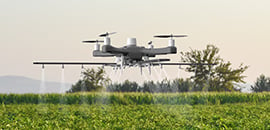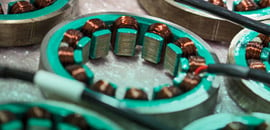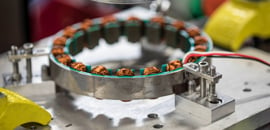Purpose
This technical paper addresses basic motor sizing with simple calculations that can be done to generally size any motor application. It will also provide a list of the main parameters to consider, and some very important criteria that is most often overlooked. Technical paper TN-9001 is closely related to this subject, and considers dynamic attributes of a servo system and how they relate to motor power and heating.
The same fundamental sizing information works in both rotary and linear motors. For simplicity, we will stay in the rotary domain using the metric system of units.
Theory Behind Motor Sizing
Most rotary electromechanical systems have a need to accelerate, run at a constant speed, and decelerate. To move any mechanical system with contacting elements, friction, damping, and any external loading must be overcome by the motor. When accelerating, additional torque must be applied to overcome inertia. While decelerating, friction and damping apply a negative torque and assist the motor with deceleration.
Motor sizing starts with a first pass estimation of all loading and a simple move profile defining the worst case acceleration and velocity requirements. This process follows Newton’s Laws of Motion.
Sizing Steps
- Define/calculate the key aspects of the motion profile required.
- Calculate/estimate all of the torque loading in the system.
- Estimate any additional torque required due to the environment or the system dynamics.
- Check your results against an initial motor selection that fits within your desired size and physical constraints.
- This is typically done using a torque versus speed curve of the motor to see if the point falls within the motor output.
- Celera Motion has a torque-speed simulation tool that can predict motor performance under customer specific unique power and thermal requirements.
- Factor in the motor itself to the system and repeat step 4 if necessary.
- Check the electrical input power requirements to see that they align with what’s available.
Motion Profile
The fastest, most demanding method of moving from point to point is a triangular move. It brings the motor to the highest speed and requires the highest overall power. It is common to use this as a first pass motion profile iteration to hone in on motor selection.

Figure 1 above is a motion profile yielding the following;
- Maximum velocity of 10 radians/sec
- Acceleration rate of 20 radians/sec2
- Deceleration rate of 20 radians/sec2
A more detailed look at the primary motion states yields the following:

Servo systems generally do not like sharp changes or disturbances in any command. Therefore, it is important to consider one of two options;
- Select the motion profile that achieves the move in 80% of the allotted time, leaving time for overshoot and settling. This safety factor can account for the dynamic torque required to meet servo loop conditions.
- Size the motor within its continuous torque range, allowing it to use the intermittent torque to cover overshoot and settling, which we are calling the dynamic torque requirement.
Sometimes, smoothing is done to this motion profile in order to minimize the rate of change of acceleration, or a trapezoidal profile is used to minimize the overshoot and reduce maximum speed. All of these solutions work to reduce the peak torque at speed and power required. They also lengthen the time of the move.
Motor Sizing Example
Step 1: Motion Profile
We will use the motion profile above in Figures 1 and 2. Acceleration of 20 rad/sec2 and required speed of 10 rad/sec2.
Step 2: Calculate/Estimate Torque Required
Torque Required =
- Torque required to Accel/Decel the load (pick the higher of the two), units of NM
- Friction torque of the load, NM
- Damping torque of the load, NM/radian/sec
- Other Torque (externally applied load, dynamic load torque), NM
- Internal motor friction, NM
- Internal motor damping, NM/radian/sec
- Torque required to Accel/Decel the motor itself, NM
Definitions:
Friction = Torque that opposes motion. Units, NM
Damping = Torque that is proportional to speed, Units, NM/rpm or NM/rad/sec
Acceleration Torque = Torque required to overcome inertia, friction and damping
Deceleration Torque = Torque required to slow down inertia. Friction and damping help you in this case.
Dynamic Torque = Additional torque required to achieve dynamic response and settling of the mechanical system. This is driven by the system bandwidth goals.
Calculate Acceleration/Deceleration Torque
In this section we will utilize Newton’s 2nd law: = , or = (in rotary form)
T = torque (NM)
J = inertia (Kg-M2)
A = Acceleration in radian/sec2
This calculation cannot be complete without some estimate of the system inertia, J. In most cases, there is a solid model of the proposed system, and assigning material properties will yield an estimation of moving inertia about the axis is question. There are a host of simple equations that can also be used for known objects, for example, J = ½ m r2 where m is mass and r is the radius of a spinning disk.
Assuming our example system has an inertia of 0.03 Kg-M2 we can move on and calculate the acceleration torque.
= ∗ = 0.03 * 20 = 0.6 NM of torque required for acceleration and deceleration.
Add up all Friction Components of the assembly
Friction is mainly caused by the bearings. Deep groove industry standard bearings tend to have very low rolling (dynamic) friction. As loading (axial or radial) increases, the friction increases. It is best to contact the bearing supplier to confirm friction levels. Due to grease and other factors, many bearings also have a static friction (stiction) that exceeds the rolling friction. This needs to be accounted for in your tally of the torque loading, and it is a non-linear contribution that may depend on temperature.
Thin cross-section low profile bearings have significantly more drag or friction torque. Both static friction and rolling friction is high in these bearings due to the smaller and higher quantity of balls and precision tolerances. It is not common for a bearing supplier to know the friction characteristics of these bearing types because the bearings can conform to the bearing journals in machined parts and take on new shapes. It is best to test these types of bearings.
Most bearings do not have significant damping. This information is even less available with bearing suppliers.
In our example, let’s assume that the system has .25 NM of bearing friction and minimal static friction.
Add up all the Damping components of the assembly
Damping is very hard to simulate and predict. It comes in many forms, viscous damping in lubricated parts, eddy currents in magnetic systems, and windage in rotating parts if the surface speed is high. Damping is a torque that is proportional to speed. It is measured in NM/rpm or NM/radian/sec.
Let’s assume our example has damping torque of .01 NM/rad/sec.
Total Torque Required
Torque required = Acceleration (deceleration) Torque + Friction + Damping
What we know (from Figure 1 above):
- The acceleration rate is 20 radian/sec2
- The deceleration rate is also 20 radian/sec2
- The friction torque from bearings is .25 NM
- The damping torque from the bearings is 0.1 NM/rad/sec
Torque Required = 0.6 NM (accel) + 0.25 NM (friction) + 0.1 NM (damping @ 10 rad/sec) = 0.86 NM
Note: Deceleration is typically not considered because friction and damping help to slow down the system so the dominant term is acceleration not deceleration. Of course, that would change if for some reason there was a rapid deceleration required.
Step 3: Estimate/Consider Other Torque Loading
Dynamic Torque is an excess torque over and above acceleration, friction and damping that may be required to handle high accelerations caused by a servo system trying to achieve high bandwidth dynamic response. It is customary to add 20% to the required numbers as a safety factor to compensate for this.
Step 4: Look for Available Solutions
Motor performance is generally defined by a torque output versus speed curve. This curve provides an operating envelope that the motor can achieve with a given set of electrical inputs and environmental thermal limits used during its design verification phase.

Motor sizing calculations
Torque speed curves can be calculated for any motor using these electrical and thermal limits. Thermal limits can also be altered by changing the motor environment or adding passive or active cooling to the motor housing.
The blue dot in this curve represents the torque required at the speed required for our example application. For the motor to operate without overheating, the requirement must be below the available output torque with some safety margin as discussed above. Safety margin should cover system unknowns, low voltage conditions, variability in motor parameters per the manufacturer’s datasheet, etc. Note: speed is normally observed in RPM, but calculations are done in radians/sec.
It is customary to show two sets of data for a motor: continuous torque and intermittent (peak) torque. The intermittent range is also limited by a duty cycle, meaning you cannot operate in that region unless you are below the continuous torque for a portion of the time. Most rapid positioning moves utilize the intermittent region of the motor performance.


The motor controller, feedback device, and power supply are very integral to the system performance. There may be conditions that limit torque based on how well the components of this system are matched and electrically aligned. For example; electronic phase alignment between the feedback and motor can impact the commutation algorithms and torque output. Also, a power supply that cannot support the input power required for a given output will choke the system and limit the motor output.
Step 5: Factoring in the Motor itself
As discussed previously, the motor is usually selected with a torque and speed point as well as mechanical size. Every motor has inertia, friction and damping. All three terms must be considered as part of the system. They should be factored back into the above calculations based on the sizing steps.
Because this is an iterative process, one must pick the highest priority for this project. In most cases with Celera Motion, mechanical size drives the selection process, torque output is next in line.
Estimation steps:
I . Find motor in the catalog/website that matches the initially desired form factor: Outside diameter, inside diameter, (or shaft size if it is a motor assembly), and length.
AI. Look at the torque speed curve for the motor selected.
a. Celera Motion has a torque speed simulation tool that can evaluate any motor at the power input and thermal conditions of the application.Call Celera Motion for application assistance.
BI . Check the “torque required” point against the curve. In our example we need .86 NM at 10 radian/sec (95.5 rpm).
IV . Now, you must factor in the motor inertia. Compare the motor inertia to the load inertia above.
a. If its value is <10% of the load inertia, you are done.
b. If its value is >10% of the load inertia, an iterative step must be performed to adjust the required torque by this amount. The extra torque required should be a direct ratio of additional inertia.
c. If this puts you into the intermittent zone then duty cycle must be evaluated, i.e. how long will you be in the zone compared to time outside the zone below the continuous rating
V. When selecting a motor you will find one of three results:
a. Your system fits well within the torque and speed of many motors in this size and you can select based on size alone.
b. There are plenty of motors that meet the torque points you have in your selected size, but they cannot run fast enough.
c. Plenty of motors meet the speed point, but within the size constraints, torque is a problem.
a.If speed is a problem, then consider increasing the voltage or looking for another winding selection that has higher speed capability. Higher speed motors have lower impedance (resistance and inductance). So a quick look at lower resistance values in the same motor family will give you the answer. If one doesn’t exist, contact Celera Motion and see if there is another winding option.
b.If torque is a problem, you need to consider a larger diameter motor or better thermal conditions, like special cooling. A longer motor should not be the first option unless your assembly can only handle length. The only time a longer motor makes sense under these conditions is when the motor inertia is higher than the load.
Repeat moves with duty cycle.
In most positioning applications, the moves repeat at some frequency. Multiple moves with dwell time in between moves can be evaluated for the torque requirements, power requirements, and temperature impact using duty cycle calculations.
Duty Cycle = 100 * (time on)/(time on + time off), units of %. The plot in Figure 6 shows repeat moves with 50% duty cycle.

When doing multiple moves at a duty cycle, the RMS torque of the system can help you define the heating or allow you to operate in the intermittent zone of the torque speed curve.
Using the move profile in Figure 6. The RMS torque can be calculated as follows:
Torquerms = �(Move Torque 2 ∗ move time + Dwell Torque2 ∗ dwell time)/cycle time
In this example; �(.73 + 0)/2 = .6 NM of RMS torque.
We know now that when this motor operates, it will only require an RMS torque of .6 NM. This will lower the motor heating because the motor spends ½ the time off. An RMS value 70% of the torque will result in 50% of the heating, which is mainly related to the square of the current.
The Most Overlooked Items – Motor Sizing
1. Not having enough extra torque to meet the dynamic needs of the system. Most highly dynamic systems used for rapid point to point moves require extra motor torque output well above the calculated load point to achieve high stiffness and fast settling. For these systems, it is common to use much higher voltage, so the motor is operating in the current controlled region in the event that the servo system demands high torque. It is common to see 15-30% more instantaneous torque required to meet dynamic stiffness and settling in high duty cycle rapid moves. See Technical Paper ‘Servo Loop, Bandwidth Motor Sizing and Power Dissipation‘ for servo dynamic analysis and how it impacts motor sizing. High bandwidth systems can put additional constraints on motor torque and power.
2. Thermal environment and application thermal limits. Most motors have aggressive thermal ratings, allowing the inside temperatures to approach 150C. Manufacturers take advantage of the best test conditions, low ambient temperatures, large mounting surfaces, and high temperature insulation systems. This makes the motor torque high, but if these conditions are not duplicated by the customer, the available torque output will be lower. Also, many applications cannot handle high temperatures because of limitations on surrounding components or thermal expansion. If this is the case, the motor may need to be de-rated.
3. Unknown loading in the system that was not accounted for in the design. It comes in two forms, friction torque from the bearings and dynamic instability caused by low natural resonance frequencies that cause vibration to be excited in the structure. These unwanted dynamic conditions can cause very high torque requirements. Also, most every application ends up with higher inertia than predicted. So plan for extra torque.
4. Electrical miss-match between the motor controller and motor. Most modern motor controllers use PWM (pulse width modulation) switching when applying voltage to the motor. When motor inductance is low, the motor is not a very good filter. High-frequency voltage will create a corresponding current ripple in the motor. This heats up the motor and motor controller. It also creates electrical noise in the system. Most motor controllers now offer adjustable PWM frequency for compatibility with a wide range of motor inductance. Low voltage applications with small motors usually drive this high current ripple condition. Reference Celera TN-2002 for more on achieving optimum performance with low inductance motors.
5. Cogging torque and its impact on overall torque ripple the motor induces on the system. This is prevalent in motors and can really impact smoothness on lightly loaded systems. If smoothness is paramount, the ideal option is to use a slotless motor, where cogging torque is zero. See Celera Motion TN 2001 on slotless versus slotted motors.
6. Torque ripple (not cogging torque related). Brushless permanent magnet motors are also known asynchronous motors (most are of the three-phase variety). Driving a synchronous motor with a sinusoidal current is the most common approach. Sinusoidal theory of a constant rotating flux vector in the motor requires that sine waves from the motor and the controller are balanced in amplitude, if not, a torque ripple will be induced in the system.
7. Referring to Technical Paper ‘Servo Loop, Bandwidth Motor Sizing and Power Dissipation‘, there is a condition when the motor is trying to track another system with high bandwidth and with high frequency disturbances where motor power could get very high. This translates to high requirements for torque and speed. This type of system is not easy to select a motor for. One must look at the frequency and the highest disturbance, then calculate the dynamic torque required from the inertia. This will usually put you at a point on the torque speed curve that you didn’t expect form the static sizing discussed in this paper above.
Conclusion
Sizing a motor is really a lesson in how much you really know about your load. The key principals are simple and based on Newton’s laws of motion. The complicated aspects are driven by real-world estimations of some complicated non-linear mechanical systems.
The best rule of thumb is to select a motor that can meet all of your known conditions within its continuous thermal rating and a speed region where torque is constant. This leaves higher intermittent torque and speed for conditions to cover things that were not planned for. Things like dynamic torque required for servo compensation, higher friction or temperature extremes, and the inevitable higher inertia than you calculated can be mitigated using this method.







